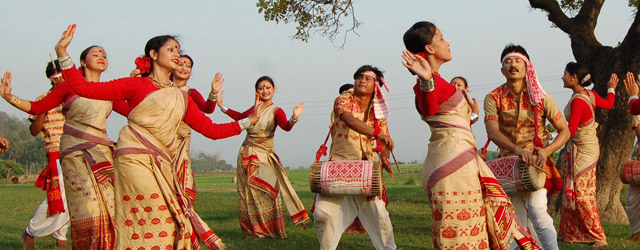The page provides some short essays on Bihu Festival, that students can go through and prepare for school assignments on Bihu Festival essay. These short Bihu Festival essays summarise the festival and its celebration. For writing an essay on Bihu Festival, the most important festival of Assam, students can go through the below ones and write one in their own words.
Bihu Festival Essay-1
Bihu is the most popular festival in Assam and is celebrated to honour the significance of agriculture in rural Assamese life. The festival is celebrated thrice in a year which marks three distinct phases in cultivation of paddy, the native crop of Assam. Bohaag Bihu or Rongaali Bihu is celebrated in the month of Baisakhi and marks the advent of planting. The Kati Bihu is celebrated on completion of sowing season in the month of Kartik, while Magh Bihu symbolises culmination of harvesting period and is celebrated in the month of Magh.
Rongaali Bihu is the most important among all the Bihus and is celebrated in the month of Bohaag (Baisakhi), the first month of Assamese calendar. It marks the advent of Assamese New Year and is therefore, marked with immense zeal and merriment. The festival also marks the beginning of spring season, when the nature adorns itself beautifully with flowers and blossoms, adding to the happiness of the festival. Therefore, it is known as Rongaali Bihu or the festival of merriment.
Bihu Festival Essay-2
Bihu is the national festival of Assam, which marks three distinct phases of the farming calendar for paddy, the native crop of Assam. The people of Assam celebrate three types of Bihu every year – Rongaali Bihu, Kati Bihu and Magh Bihu. Rongaali Bihu or Bohaag Bihu is celebrated in the month of Bohaag (middle of April) and marks the beginning of the seeding time. It is the chief Bihu of all the three and is celebrated over a period of several days. The Kati Bihu, also known as Kongaali Bihu, marks the completion of sowing of paddy and transplantation of saplings. The Magh Bihu or the Bhogaali Bihu celebrates the culmination of the harvesting period.
Traditionally, Bihu is celebrated with folk dance and songs which are symbolic of communication of love and romance. Today, cultural programs are held based on Bihu dance and songs, accompanied by traditional musical instruments like the Dhol, Toka, Pepa, etc. Kati Bihu is celebrated in the middle of October, when people perform silent prayer by lighting earthen lamps in the paddy fields. On the other hand, Bhogaali Bihu is celebrated in January after the cultivation is harvested. Bihu festival is celebrated with immense zeal and passion, irrespective of caste, creed and religion.
Bihu Festival Essay-3
Bihu Festival is a set of three unique cultural festivals of Assam that is celebrated by the Assamese around the world. Assam is the state of agriculture and Bihu is a festival that commemorates major agricultural events. Traditionally, there are three Bihu festivals in a year, namely Rongaali Bihu, Kati Bihu and Magh Bihu, which marks three distinctive phases in the farming calendar. Bihu is a non-religious and secular festival, and everyone, irrespective of religion, caste and creed celebrates this occasion with joy and merriment.
Bohaag Bihu or Rongaali Bihu is the most popular of all and marks the arrival of spring season. The festival is celebrated over several days and is a period of great fun and enjoyment. Traditional folk songs and dances are the main attraction of this festival. Bohaag Bihu is celebrated in April, Kati Bihu in October and Magh Bihu in the month of January every year. Every occasion has its own significance. Cultural traditions make the festival most enjoyable and popular across the world.









